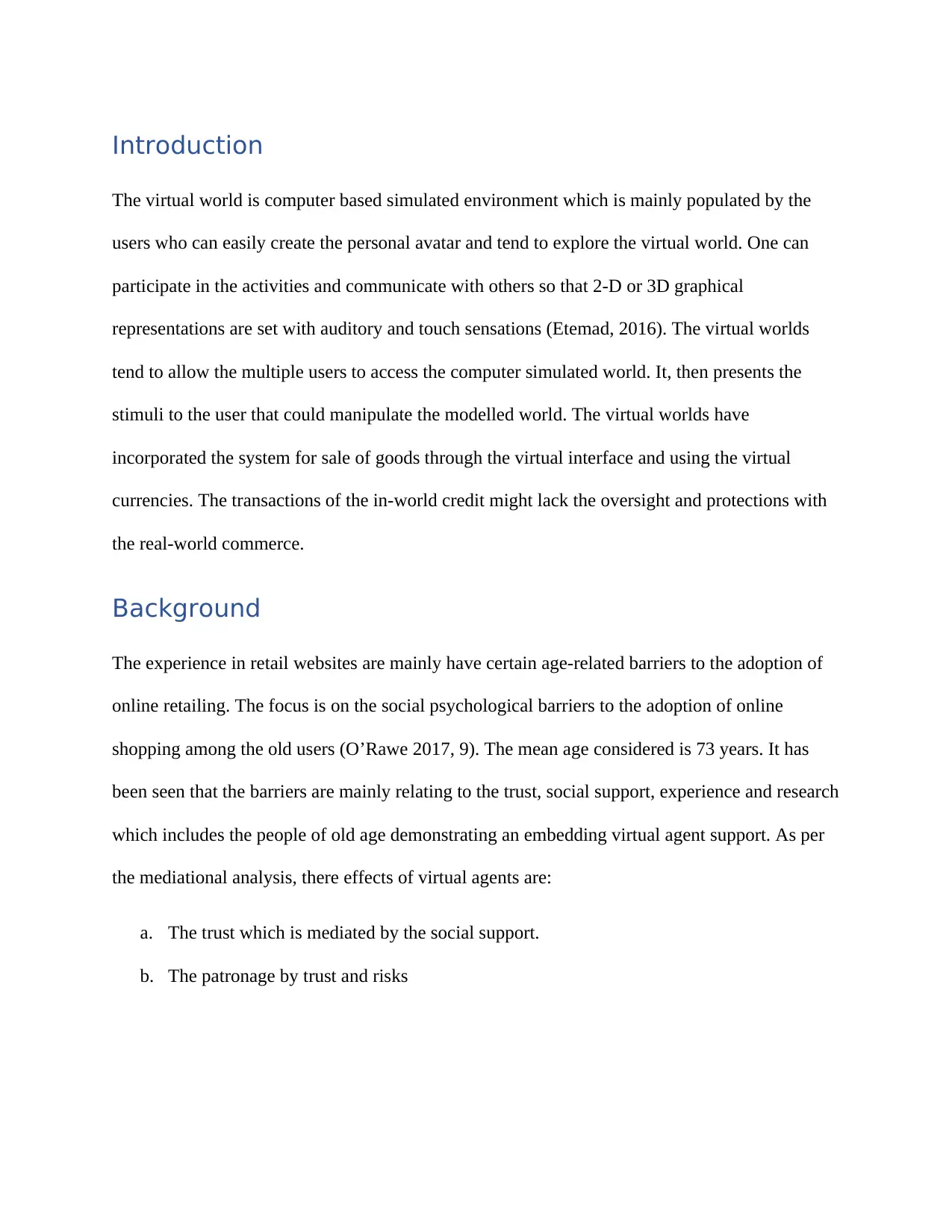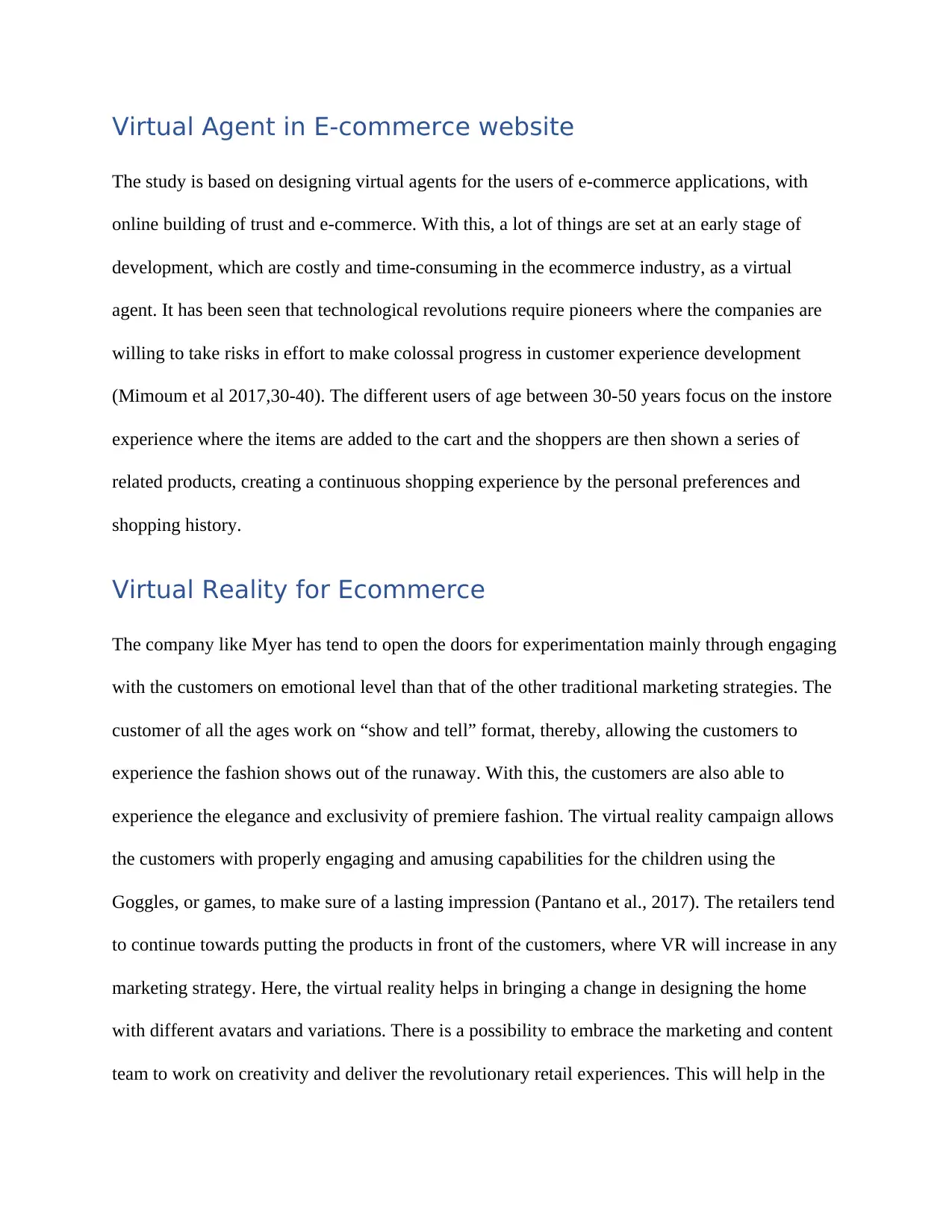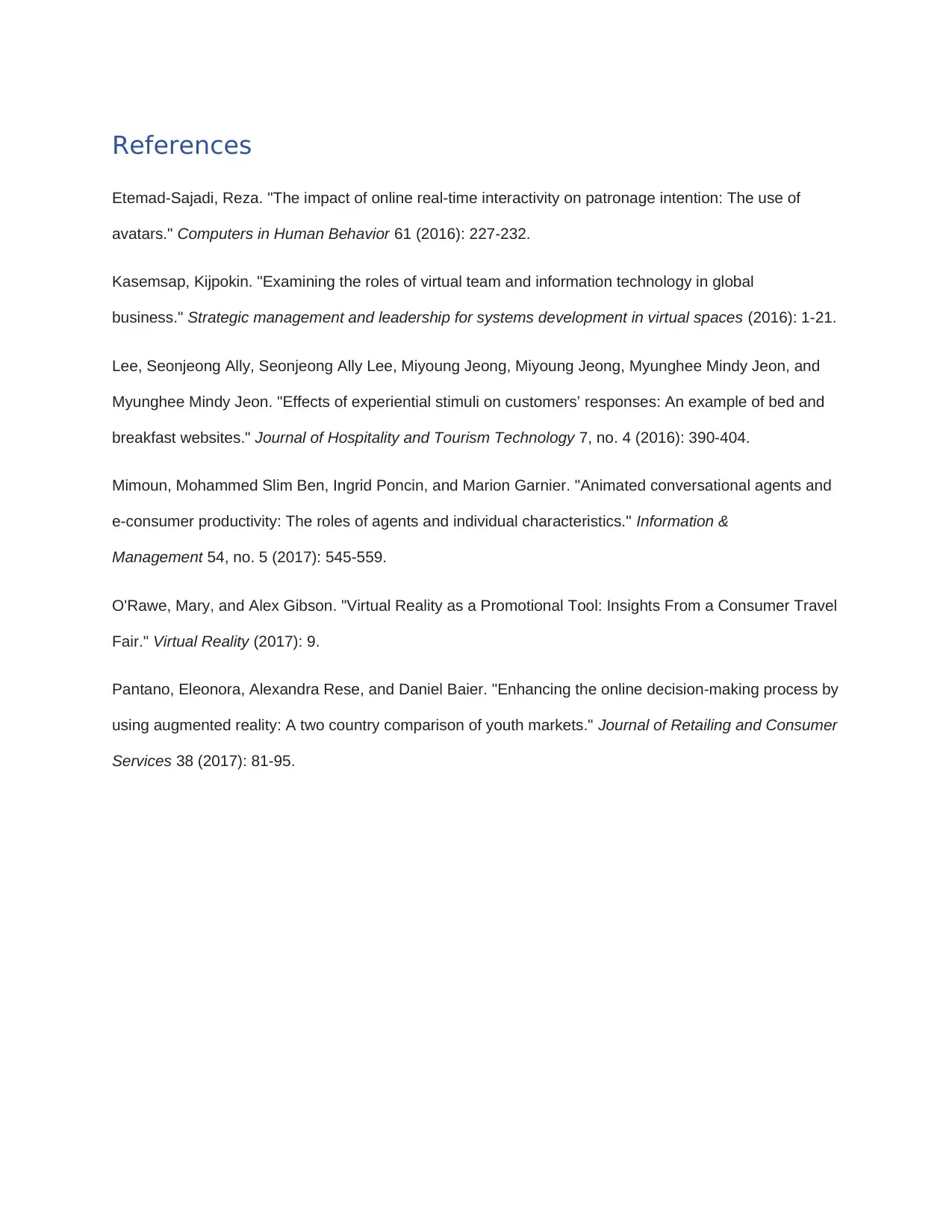Examining VR and Virtual Agent Effects in E-commerce Across Age Groups
VerifiedAdded on 2020/04/15
|7
|1112
|126
Report
AI Summary
This report examines the effects of virtual reality (VR) and virtual agents on e-commerce websites, focusing on how these technologies influence customer experiences across different age groups. It explores the benefits of simulating social interaction with virtual agents, addressing age-related barriers to online shopping adoption, such as trust and social support. The report discusses the use of VR for immersive experiences, like fashion shows and home design, and the potential for retailers to leverage these technologies to enhance customer engagement. The analysis covers the implementation of VR in marketing strategies and the creation of personalized shopping experiences. The conclusion emphasizes the role of VR and virtual agents in creating better online shopping environments, offering 3D product views, customized voiceovers, and virtual checkout options, ultimately catering to a wide range of users, from children to older adults.

Effects of virtual reality and virtual agent in e-commerce website: An examination across age
Paraphrase This Document
Need a fresh take? Get an instant paraphrase of this document with our AI Paraphraser

Abstract
The study is about different benefits related to simulating the social interaction with social
presence through virtual agents for the older users. The virtual reality has been able to spread in
the entertainment industry which has embraced the needs of the customers for omnichannel
experiences, with strong focus on mobile optimisation. The mobile sessions grow with the
desktop sessions depending upon the evolution of marketing and engagement. Here, 3D printing,
facial recognition software and the wearable tech picking team demand and expect for the
experiential retail practices.
The study is about different benefits related to simulating the social interaction with social
presence through virtual agents for the older users. The virtual reality has been able to spread in
the entertainment industry which has embraced the needs of the customers for omnichannel
experiences, with strong focus on mobile optimisation. The mobile sessions grow with the
desktop sessions depending upon the evolution of marketing and engagement. Here, 3D printing,
facial recognition software and the wearable tech picking team demand and expect for the
experiential retail practices.

Contents
Abstract............................................................................................................................................1
Introduction......................................................................................................................................2
Background......................................................................................................................................2
Virtual Agent in E-commerce website............................................................................................2
Virtual Reality for Ecommerce........................................................................................................3
Conclusion.......................................................................................................................................4
References........................................................................................................................................5
Abstract............................................................................................................................................1
Introduction......................................................................................................................................2
Background......................................................................................................................................2
Virtual Agent in E-commerce website............................................................................................2
Virtual Reality for Ecommerce........................................................................................................3
Conclusion.......................................................................................................................................4
References........................................................................................................................................5
⊘ This is a preview!⊘
Do you want full access?
Subscribe today to unlock all pages.

Trusted by 1+ million students worldwide

Introduction
The virtual world is computer based simulated environment which is mainly populated by the
users who can easily create the personal avatar and tend to explore the virtual world. One can
participate in the activities and communicate with others so that 2-D or 3D graphical
representations are set with auditory and touch sensations (Etemad, 2016). The virtual worlds
tend to allow the multiple users to access the computer simulated world. It, then presents the
stimuli to the user that could manipulate the modelled world. The virtual worlds have
incorporated the system for sale of goods through the virtual interface and using the virtual
currencies. The transactions of the in-world credit might lack the oversight and protections with
the real-world commerce.
Background
The experience in retail websites are mainly have certain age-related barriers to the adoption of
online retailing. The focus is on the social psychological barriers to the adoption of online
shopping among the old users (O’Rawe 2017, 9). The mean age considered is 73 years. It has
been seen that the barriers are mainly relating to the trust, social support, experience and research
which includes the people of old age demonstrating an embedding virtual agent support. As per
the mediational analysis, there effects of virtual agents are:
a. The trust which is mediated by the social support.
b. The patronage by trust and risks
The virtual world is computer based simulated environment which is mainly populated by the
users who can easily create the personal avatar and tend to explore the virtual world. One can
participate in the activities and communicate with others so that 2-D or 3D graphical
representations are set with auditory and touch sensations (Etemad, 2016). The virtual worlds
tend to allow the multiple users to access the computer simulated world. It, then presents the
stimuli to the user that could manipulate the modelled world. The virtual worlds have
incorporated the system for sale of goods through the virtual interface and using the virtual
currencies. The transactions of the in-world credit might lack the oversight and protections with
the real-world commerce.
Background
The experience in retail websites are mainly have certain age-related barriers to the adoption of
online retailing. The focus is on the social psychological barriers to the adoption of online
shopping among the old users (O’Rawe 2017, 9). The mean age considered is 73 years. It has
been seen that the barriers are mainly relating to the trust, social support, experience and research
which includes the people of old age demonstrating an embedding virtual agent support. As per
the mediational analysis, there effects of virtual agents are:
a. The trust which is mediated by the social support.
b. The patronage by trust and risks
Paraphrase This Document
Need a fresh take? Get an instant paraphrase of this document with our AI Paraphraser

Virtual Agent in E-commerce website
The study is based on designing virtual agents for the users of e-commerce applications, with
online building of trust and e-commerce. With this, a lot of things are set at an early stage of
development, which are costly and time-consuming in the ecommerce industry, as a virtual
agent. It has been seen that technological revolutions require pioneers where the companies are
willing to take risks in effort to make colossal progress in customer experience development
(Mimoum et al 2017,30-40). The different users of age between 30-50 years focus on the instore
experience where the items are added to the cart and the shoppers are then shown a series of
related products, creating a continuous shopping experience by the personal preferences and
shopping history.
Virtual Reality for Ecommerce
The company like Myer has tend to open the doors for experimentation mainly through engaging
with the customers on emotional level than that of the other traditional marketing strategies. The
customer of all the ages work on “show and tell” format, thereby, allowing the customers to
experience the fashion shows out of the runaway. With this, the customers are also able to
experience the elegance and exclusivity of premiere fashion. The virtual reality campaign allows
the customers with properly engaging and amusing capabilities for the children using the
Goggles, or games, to make sure of a lasting impression (Pantano et al., 2017). The retailers tend
to continue towards putting the products in front of the customers, where VR will increase in any
marketing strategy. Here, the virtual reality helps in bringing a change in designing the home
with different avatars and variations. There is a possibility to embrace the marketing and content
team to work on creativity and deliver the revolutionary retail experiences. This will help in the
The study is based on designing virtual agents for the users of e-commerce applications, with
online building of trust and e-commerce. With this, a lot of things are set at an early stage of
development, which are costly and time-consuming in the ecommerce industry, as a virtual
agent. It has been seen that technological revolutions require pioneers where the companies are
willing to take risks in effort to make colossal progress in customer experience development
(Mimoum et al 2017,30-40). The different users of age between 30-50 years focus on the instore
experience where the items are added to the cart and the shoppers are then shown a series of
related products, creating a continuous shopping experience by the personal preferences and
shopping history.
Virtual Reality for Ecommerce
The company like Myer has tend to open the doors for experimentation mainly through engaging
with the customers on emotional level than that of the other traditional marketing strategies. The
customer of all the ages work on “show and tell” format, thereby, allowing the customers to
experience the fashion shows out of the runaway. With this, the customers are also able to
experience the elegance and exclusivity of premiere fashion. The virtual reality campaign allows
the customers with properly engaging and amusing capabilities for the children using the
Goggles, or games, to make sure of a lasting impression (Pantano et al., 2017). The retailers tend
to continue towards putting the products in front of the customers, where VR will increase in any
marketing strategy. Here, the virtual reality helps in bringing a change in designing the home
with different avatars and variations. There is a possibility to embrace the marketing and content
team to work on creativity and deliver the revolutionary retail experiences. This will help in the

mass market uptake in effective manner (Lee et al., 2016). Here, the retailers are trying to
explore on making use of the technology with properly demonstrating a readiness to embrace this
immersive technology.
Conclusion
The virtual reality and agents are helpful to create a better online-shop where the retailers can
provide the 3D image of the products and stores, add the customised voiceovers and other
sounds. One can also create a virtual checkout for the customers to buy the products and work on
the cloud system platforms (Kasemsap, 2016). There are unlimited number of products and
categories for the different users, like the toys for the children, games for the youth, shaping or
designing the home for the people of age 40-50 years.
explore on making use of the technology with properly demonstrating a readiness to embrace this
immersive technology.
Conclusion
The virtual reality and agents are helpful to create a better online-shop where the retailers can
provide the 3D image of the products and stores, add the customised voiceovers and other
sounds. One can also create a virtual checkout for the customers to buy the products and work on
the cloud system platforms (Kasemsap, 2016). There are unlimited number of products and
categories for the different users, like the toys for the children, games for the youth, shaping or
designing the home for the people of age 40-50 years.
⊘ This is a preview!⊘
Do you want full access?
Subscribe today to unlock all pages.

Trusted by 1+ million students worldwide

References
Etemad-Sajadi, Reza. "The impact of online real-time interactivity on patronage intention: The use of
avatars." Computers in Human Behavior 61 (2016): 227-232.
Kasemsap, Kijpokin. "Examining the roles of virtual team and information technology in global
business." Strategic management and leadership for systems development in virtual spaces (2016): 1-21.
Lee, Seonjeong Ally, Seonjeong Ally Lee, Miyoung Jeong, Miyoung Jeong, Myunghee Mindy Jeon, and
Myunghee Mindy Jeon. "Effects of experiential stimuli on customers’ responses: An example of bed and
breakfast websites." Journal of Hospitality and Tourism Technology 7, no. 4 (2016): 390-404.
Mimoun, Mohammed Slim Ben, Ingrid Poncin, and Marion Garnier. "Animated conversational agents and
e-consumer productivity: The roles of agents and individual characteristics." Information &
Management 54, no. 5 (2017): 545-559.
O'Rawe, Mary, and Alex Gibson. "Virtual Reality as a Promotional Tool: Insights From a Consumer Travel
Fair." Virtual Reality (2017): 9.
Pantano, Eleonora, Alexandra Rese, and Daniel Baier. "Enhancing the online decision-making process by
using augmented reality: A two country comparison of youth markets." Journal of Retailing and Consumer
Services 38 (2017): 81-95.
Etemad-Sajadi, Reza. "The impact of online real-time interactivity on patronage intention: The use of
avatars." Computers in Human Behavior 61 (2016): 227-232.
Kasemsap, Kijpokin. "Examining the roles of virtual team and information technology in global
business." Strategic management and leadership for systems development in virtual spaces (2016): 1-21.
Lee, Seonjeong Ally, Seonjeong Ally Lee, Miyoung Jeong, Miyoung Jeong, Myunghee Mindy Jeon, and
Myunghee Mindy Jeon. "Effects of experiential stimuli on customers’ responses: An example of bed and
breakfast websites." Journal of Hospitality and Tourism Technology 7, no. 4 (2016): 390-404.
Mimoun, Mohammed Slim Ben, Ingrid Poncin, and Marion Garnier. "Animated conversational agents and
e-consumer productivity: The roles of agents and individual characteristics." Information &
Management 54, no. 5 (2017): 545-559.
O'Rawe, Mary, and Alex Gibson. "Virtual Reality as a Promotional Tool: Insights From a Consumer Travel
Fair." Virtual Reality (2017): 9.
Pantano, Eleonora, Alexandra Rese, and Daniel Baier. "Enhancing the online decision-making process by
using augmented reality: A two country comparison of youth markets." Journal of Retailing and Consumer
Services 38 (2017): 81-95.
1 out of 7
Related Documents
Your All-in-One AI-Powered Toolkit for Academic Success.
+13062052269
info@desklib.com
Available 24*7 on WhatsApp / Email
![[object Object]](/_next/static/media/star-bottom.7253800d.svg)
Unlock your academic potential
Copyright © 2020–2025 A2Z Services. All Rights Reserved. Developed and managed by ZUCOL.





